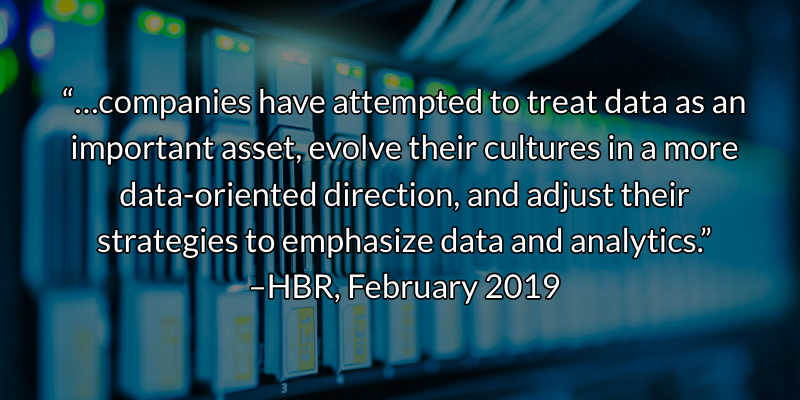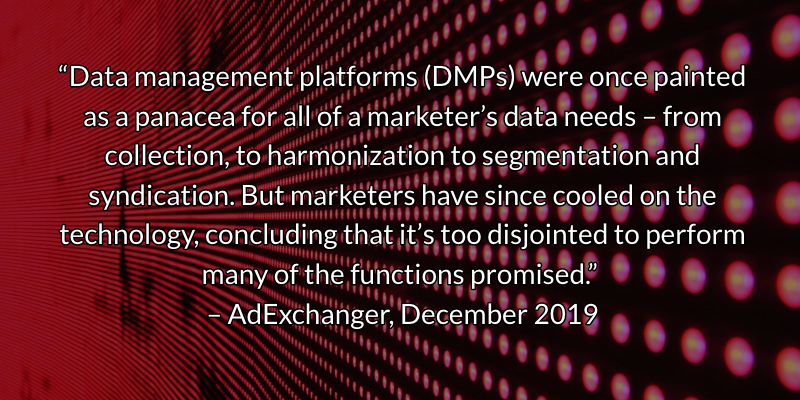Creating digital and customer experience success requires more thinking and planning, not more expensive marketing technology. Here’s what you need to know.
In the Sitecore ebook titled “5 hard truths for marketers driving digital experience,” there was an observation that the role of the marketer had changed significantly in the last few years. It said that marketers find themselves “…on the front line driving better customer and digital experiences.”
That last sentence is partially correct. In my experience speaking and working with thousands of global marketers over the years, I’ve found the desire to provide better customer and digital experiences present. Still, to be accurate, I’d change the line to “…struggling to drive better customer and digital experiences.” Here are the “five truths” laid out in the Sitecore ebook, along with some thoughts on each.
The C-Suite is just not that into you
“In business terms, you can often be speaking completely different languages. What is the value of impressions or clicks to a business? Surely sales are the only thing that matter? C-Suites often don’t understand the resources or efforts necessary to deliver effective digital experiences, so they are naturally going to focus on metrics with simple, provable outcomes, at the expense of marketing.”
Indeed, most C-level executives are myopically focused on measurable outcomes that drive EBITDA. There’s no disconnect here; every marketer I’ve ever encountered understands that when the company makes money, paychecks are issued, and everyone keeps their jobs.
What’s causing the so-called CMO confidence crisis in the C-suite is the simple fact that a majority of marketers don’t have a measurement plan. They’re doing plenty to move the needle; the problem is they don’t measure those efforts effectively (or at all). And they can’t prove ROI, which is why marketing organizations are often viewed as cost centers by leadership.
As my favorite sage on digital marketing and measurement, Avinash Kaushik says, “The root cause of failure in most digital marketing campaigns is not the lack of creativity in the banner ad or TV spot or the sexiness of the website. It is not even (often) the people involved. It is quite simply the lack of structured thinking about what the real purpose of the campaign is and a lack of an objective set of measures with which to identify success or failure.”
What are you trying to accomplish, and how will you measure success or failure? Brilliant and significant. Try it and see how your credibility and value proposition with everyone in your organization, not just the C-Suite, grows exponentially along with your success.
Personalization is not a one-size-fits-all
“There is no one-size-fits-all solution for any business. The idea behind personalization is it is unique. What works for one person/sector/business will not be suitable for another. Working out what works for you is a major challenge.”
The over-hyped promise of reduced costs, higher efficiency, and more revenue when you personalize your customers’ experiences has created a sense of FOMO in marketers the likes of which we haven’t seen since the pet rock and more recently, with social media. Creating personalized experiences is the talk at marketing conferences around the world, and research in the wild supports the suggestion that prospects and customers prefer personalized experiences.
Further, if you buy-in to the studies (in large part published by organizations that make money selling personalization services), personalized experiences can be a boon for the bottom line:
- 80% of customers are more likely to purchase a product or service from a brand that provides personalized experiences. [Epsilon]
- The top five benefits of personalization include increased visitor engagement (55%), improved customer experience (55%), improved brand perception (39%), increased conversion rates (51%) and increased lead generation and customer acquisition (46%) [Evergage]
- Personalization can reduce acquisition costs by as much as 50%, lift revenues by 5–15%, and increase marketing spend efficiency by 10–30% [McKinsey]
IMHO, the “major challenge” is that riding the personalization wave comes at a cost – a cost most marketing organizations never really consider. You’ll need the right people, you’ll have to do some work, it’ll take time, and you’ll have to invest substantial dollars. There’s no “Easy Button” or Magical Martech solution when it comes to creating and delivering remarkable personalized customer experiences, despite what you read and hear from marketing technology vendors
It’s worth repeating; for personalization initiatives to have any chance of succeeding, you’ll need the right people, you’ll have to do some work, it’ll take time, and you’ll have to invest substantial dollars. That’s the reality of personalization. Depending on your strategy and activation methods, which include technology, the quantitative measures of each of those things will vary – sometimes significantly. As the Sitecore ebook says, there is no one-size-fits-all solution for any business.
AI alone won’t save you
“AI is just a tool, like your computer or notepad. There might be a time in the future where you couldn’t possibly imagine working without it, but it needs you a lot more than you need it. If you’re struggling to come up with new ideas, or convert plans into reality, AI won’t help you.”
If I read one more article confidently assuring me that, “AI is the future of marketing,” I’m going to pinch someone. Really hard. First, it was customer experience, and then personalization, now it’s machine learning, artificial intelligence, IoT, and let’s not forget account-based marketing. It’s exhausting.
Most of the marketers I work with are struggling to keep up with a customer who moves faster than their brand. If they had to make a list of things on which to spend their precious time, money, and effort to move the needle, artificial intelligence wouldn’t be on it. Marketing technology vendors or consultants who tell you the answer to your marketing quandaries is AI probably have a bridge they want to sell you, as well.
AI for marketers is at a nascent stage, at best. Consider building knowledge about AI today, but wait another few years before investing budget and effort in major AI initiatives. Focus instead on developing your business, marketing, and technology goals to help you acquire, convert, and retain. The rewards from that investment today will likely be much higher than an investment in AI.
If you have a major jones for the AI thang, after developing your business, marketing, and technology goals, consider doing some research on chatbots. There might be a fit within your strategy for AI-powered conversational chatbots that use instant messaging to chat in real-time, any time, with site visitors or customers. It’s an excellent way to ease into AI.
- Autodesk leveraged the Watson Conversation platform to build a virtual agent that resulted in a 99 percent improvement in response times, “…cutting resolution from 38 hours to 5.4 minutes for most Tier 1 inquiries.” [IBM]
- Gartner predicts that chatbots will power 85 percent of all customer service interactions by the year 2020, becoming a mainstream customer experience investment. 47% of organizations will use chatbots for customer care, and 40% will deploy virtual assistants.
For the record, I’m a big fan of using machine learning, artificial intelligence, predictive and prescriptive analytics, and other approaches to automate processes and drive marketing success. My son recently wrapped up four years at The Ohio State University, getting his data analytics degree and is preparing to enter a Master’s program. He’ll echo what Sitecore and I are saying, that AI has its place. But it’s not the panacea the market is making it out to be.
Your content crisis won’t solve itself
“Content is king in marketing. But with so many different channels, sectors and individuals to target, you can’t create content fast enough, especially with a finite number of people and budget.”
You could create content (and publish everywhere) fast enough, but you’d need a well thought out content strategy to serve as the foundation for your efforts. It’s not that there are too many channels, sectors, or customers with whom to connect your content. The reason most marketers can’t get speed and scale from their content endeavors is that they have no plan, no content strategy.
Plus, they’re buying empty marketing technology promises from vendors promising magical outcomes. The latest and greatest “customer experience platform” isn’t going to change the fact that you’ve got to do some work to create the real magic that drives results.
- 65% of the most successful content marketers have a documented strategy vs. 14% of the least successful. [Content Marketing Institute]
- The biggest challenges for content marketing are reportedly lack of data and lack of strategy. [DMA]
- 98% of senior marketers believe having a content strategy is essential for their success, but only 55% have a documented strategy. [Contently]
That work includes understanding your market, your customers, developing business, marketing, and technology goals, and having the right people on the bus to activate the multiple strategies that will drive tangible results (revenue). Buying a bunch of Magical Martech isn’t a replacement for doing that work. As strategy consultant, Will Sullivan so rightly says, “It’s not magic, it’s martech.”
Just a few years ago, Econsultancy said: “Unused content in B2B digital marketing will soon be a $50bn problem for the industry and for CMOs keen to prove ROI.” That’s a lot of cabbage. And they were right. A robust content strategy is a roadmap to success that helps you avoid content waste and a lack of ROI. Your content strategy will:
- Define how content will be used to meet business goals and satisfy user needs. (substance)
- Guide content decisions throughout its lifecycle, from concept to deletion. (structure, workflow, governance)
- Set benchmarks to measure the success of the content. (measurement)
[H/T to Kristina Halvorson]
I’ll bet $20 bucks right now that most of the people reading this do not have a formal content strategy in place at their company (I’m not wasting time on a survey – we all fib when we do those things, anyway).
So please, don’t shortcut when it comes to content strategy. That goes for customer experience strategy and data strategy, as well. It’s a triple play that’ll change everything for your business and marketing efforts.
Customer data is your kryptonite
“Marketing collects vast amounts of data from customers, but often doesn’t fully utilize it. In fact, 72% of us want to do more with the data we have. We all have so much raw customer information just sitting there, but we either don’t trust it, or don’t realize the potential it has.”
I don’t think this failure to make use of (monetize?) customer data has anything to do with trust in the data or recognizing the potential of the data a company owns. As the Sitecore ebook says, most companies want to do more with the data they have – do more with data in general. However, as a 2019 HBR article said, companies are failing in their efforts to become data-driven.
The HBR article references NewVantage Partners’ 2019 Big Data and AI Executive Survey. Here are some results from the survey:
- 72% of survey participants report that they have yet to forge a data culture.
- 69% report that they have not created a data-driven organization.
- 53% state that they are not yet treating data as a business asset.
- 52% admit that they are not competing on data and analytics.
This survey addresses the higher level, organizational approach to being data-driven, and the results are alarming, to be sure. But let’s drop down below the corporate level and look at this from a marketing organization POV and talk a bit about the two leading data platforms marketers have been using for the past few years to aggregate data, build audiences, gain insights (e.g., patterns, trends, intent), and create personalized experiences.
Data Management Platforms (DMP)
Data management platforms have been the customer data management tool most used by marketers. DMPs aggregate first-party, second-party, and third-party data and promise to help marketers better understand their customers, including what influences them to make purchases. DMPs do this by storing and analyzing (often using AI) campaign data, segments, demographics, psychographics, and much more.
Demand-Side Platforms (DSP)
A demand-side platform (DSP) is a real-time bidding system that connects media buyers with data exchanges and supply-side platforms through a single interface. DSPs use the insights from the DMP and serve as the middleman between media buyers and publishers, providing a repository through which they can buy and sell targeted ad inventory.
Sounds great, right? The challenge is that DMPs are expensive, complicated, and require specialized skills to select, implement, and operate. Again, there’s no magic here. Becoming a data-driven marketer and using tools like a DMP requires well-defined business, marketing, and technology strategies, the right people, time, lots of work, and a substantial investment.
Many marketing organizations using DMPs have struggled to achieve ROI, often resorting to hiring consultants or in-house talent to manage their DMPs. It’s not about a lack of trust in the data or recognizing the potential of the data a company owns. It is about buying technology based on a promise that doesn’t deliver – and doesn’t serve the needs of the business.
Do you see a pattern developing here? As for DSPs, marketers are using them to programmatically buy display, video, mobile, search, and other types of ads. DSPs can deliver excellent results when driven by a well-defined business and marketing strategy, but you must choose your DSP partners carefully.
Enter the Customer Data Platform (CDP)
The customer data platform (much like DMPs were) promises to be the holy grail of customer data management. A single source of record for all customer data. A persistent, unified customer database with integration to other systems and aggregated data that are cleaned and combined to create a single customer profile.
I know, I know – you’ve got to have one of those CDP things. But before you rush off and buy yet another marketing technology tool, take a deep breath. It’s early in the CDP evolution, and right now and as with AI, I suggest a wait-and-see approach. Customer data’s not your kryptonite. Over-hyped marketing technology is your kryptonite.
When it comes to making sense of your data and using it as a tool to connect more deeply with your prospects and customers to drive revenue, there’s no Magic Martech, no “Easy Button.” Your first step to putting your data to work for your company and your customers is to develop a robust data strategy. There are no shortcuts; you’ve got to do the work.
How to Drive Better Customer and Digital Experiences
Here’s the one hard truth you should not only accept, but incorporate into the way you work. If you want to drive better customer and digital experiences, which lead to increased acquisition, conversions, and retention, it’s going to take some time, you’ll need good people, you’ll have to do some work, and it’ll require an investment.
Customer Experience Strategy
Like a good meal, remarkable customer and digital experiences take time. The upfront thinking contributes as much to success as the doing. Take all the time necessary to develop and activate a robust customer experience strategy, and you’ll not only forge ahead of your competitors, but you’ll also be less frustrated with the outcome.
Content Strategy
Equally important, your content strategy will help you and your team clearly define how content will be used to meet business goals and satisfy the needs of your users. From initial content idea to sunsetting, a content strategy will help guide your content decisions during the content lifecycle. Just as important, don’t forget to put a plan in place to measure the efficacy of your content efforts.
Data Strategy
Data strategy has traditionally focused on the storage and retention of data. With a desire for marketing organizations to become more data-driven, there’s a new foundational approach to data strategy, which includes acquiring, storing, managing, sharing, and using data. The folks at SAS describe the complexity of data strategy in five snackable components:
- Identify – Identify data and understand its meaning regardless of structure, origin or location
- Store – Persist data in a structure and location that supports easy, shared access and processing
- Provision – Package data so it can be reused and shared, and provide rules and access guidelines for the data
- Process – Move and combine data residing in disparate systems, and provide a unified, consistent data view
- Govern – Establish, manage and communicate information policies and mechanisms for effective data usage
According to research from Econsultancy, in partnership with Google, marketers who were able to crush their business goals indicated that two things are crucial to success: support from executive leadership and a clearly defined and documented data and analytics strategy.
In my work with clients across different verticals, I see this becoming more critical to success. Organizations that invest in developing, documenting, and making data strategy part of the core of organizational culture far exceed the performance of those that do not. If you don’t have the in-house expertise to explore, develop, and implement a clearly defined and documented data and analytics strategy, find a consultant who can help you figure it out.
The short-term investment will far outweigh the long-term benefits, which include empowering your marketing team to improve the customer experience, personalize content development and distribution, and maximize ROI on your investments in people, processes, and technology.
Creating a Program for Digital and Customer Experience Success
Creating remarkable digital and customer experiences requires thinking and planning before you start doing. If you want to amplify your acquisition, conversion, and retention efforts and blow the doors off your competition, you must first clearly establish (preferably in writing) your most important business, marketing, and technology goals.
Defining your content, customer experience, and data strategies come next. Think “narrowcasting” when determining these essential strategic roadmaps; your goal is to deliver the right content to the right prospects snd customers, at the right time, within the context of their customer journey.
Having a strategic data-driven content strategy along with a robust customer experience strategy helps ensure you’re putting your best content and customer experience foot forward when engaging with your target audiences. Finally, let’s remember that technology alone is not the answer to driving digital and customer experience success. While technology plays a part, there’s no “Easy” button when it comes to applying technology, and this is especially true of marketing technology to activate your strategies.
If you want to drive better customer and digital experiences, which lead to increased acquisition, conversions, and retention, remember: it’s going to take some time, you’ll need good people, you’ll have to do some work, and it’ll require an investment. And if that all feels a bit overwhelming, don’t be discouraged. While you’re reading this, your competitor likely just bought another marketing technology tool instead of doing the real work!
“Efficiency is doing things right; effectiveness is doing the right things.” – Peter Drucker
Delivering on the Promise of Personalization
The road to personalization success as promoted by marketing technology vendors, analysts, and others - all ostensibly with a dog in the race - is usually paved with rough, long, expensive toll roads. Here's what you need to know to deliver on the promise...
The Agency of Record: The Shift Is On to Specialized Agencies
The agency of record model is shifting to using smaller and mid-sized specialty agencies. The benefits include more specialized knowledge, increased value, more creativity, and better market knowledge. Is it time to fire your agency of record?
What is a Digital Strategist?
The marketing industry has been confused about the role of the digital strategist since the dawn of digital marketing itself. Here’s my take on the answer to the question, “What is a digital strategist, and what does a digital strategist do?”






0 Comments